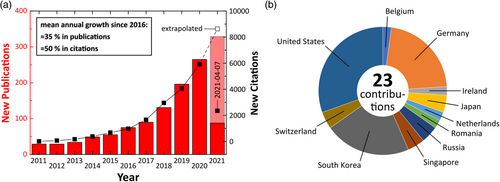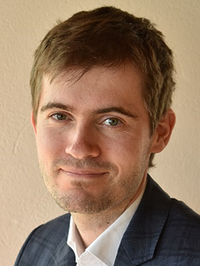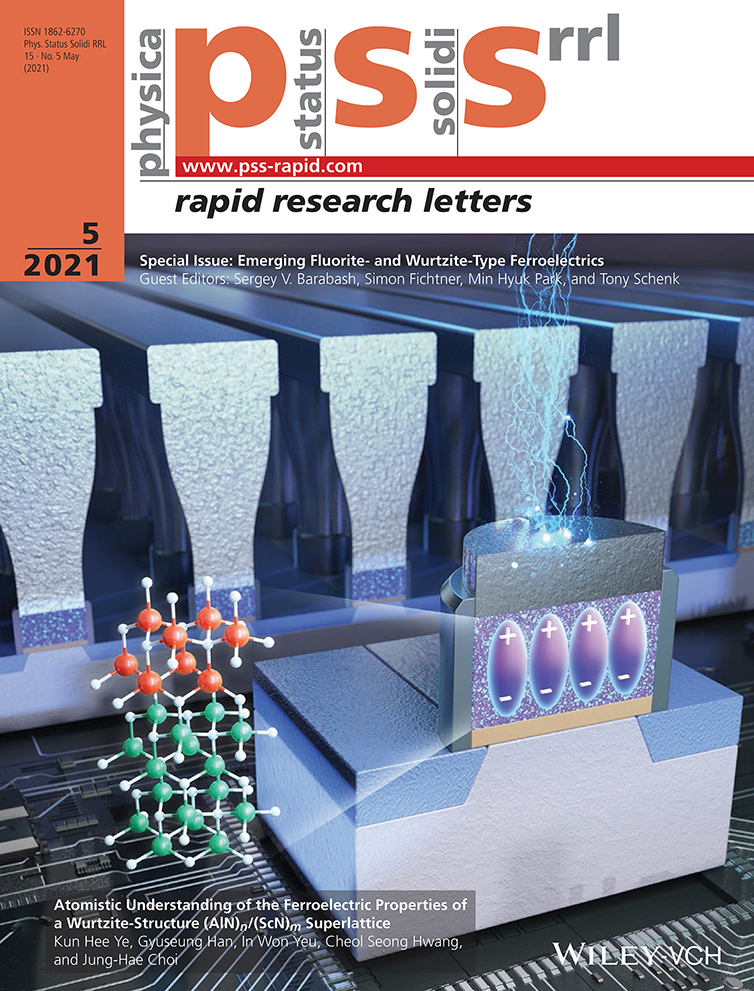Emerging Fluorite- and Wurtzite-Type Ferroelectrics: From (Hf,Zr)O2 to AlN and Related Materials
It is a great pleasure for us to present this Focus Issue in Physica Status Solidi (RRL) – Rapid Research Letters on two classes of novel ferroelectrics with rich physics and high application potential: fluorite- and wurtzite-type ferroelectrics with HfO2/ZrO2 and Al(Sc)N as their most prominent representatives.
HfO2/ZrO2-based ferroelectrics have been referred to as “the ferroelectrics of the future”.[1] They retain their polar nature in ultrathin films down to just a few nanometers and are fully compatible with state-of-the-art complementary metal–oxide–semiconductor (CMOS) technology. The report of ferroelectricity in Si:HfO2 thin films[2] is rooted in the semiconductor industry (Qimonda, Dresden, a memory company) and, hence, researchers immediately started investigating the potential of the materials for both capacitor- and transistor-based ferroelectric memory concepts.[3, 4] As HfO2 and ZrO2 dielectrics were already incorporated in advanced CMOS devices, process integration and scaling potential looked promising and the idea of establishing a non-volatile memory device by “simply making them ferroelectric” was highly attractive. This preponderance of the application perspective left the basic research on the underlying physics behind, and researchers with a strong background in ferroelectrics remained somewhat skeptical at first, reasoning that ferroelectric properties would not have been overlooked in such well-studied oxides. In recent years, our understanding of these materials gradually solidified, and the exchange between the communities became very active. Nonetheless, there remains a lot to be done, both theoretically and experimentally.
In a review article in this issue, Cao et al. (article number 2100025) summarize the state of the art in epitaxial ferroelectric HfO2 films and the role that composition, deposition conditions, and choice of substrate play for phase formation and the corresponding electrical properties.
Understanding the mechanism of phase transformations, the conditions under which the ferroelectricity is stabilized, and the landscape of the competing phases remains of great importance. Fundamental experimental work is provided by T. Shimizu et al. (article number 2000589), who experimentally demonstrated an irreversible ferroelectric phase transformation from the tetragonal phase to the orthorhombic phase in a pulsed-laser-deposited 5% YO1.5-doped Hf0.5Zr0.5O2 epitaxial film. The phase transformation was induced by an electric field and observed using scanning transmission electron microscopy and X-ray diffraction (XRD). Narasimhan et al. (article number 2000598) characterized the evolution of the phase distribution in atomic-layer-deposited polycrystalline HfO2 films by in situ XRD during rapid thermal annealing. They reveal complex phase transformations occurring on the scale of seconds. In a combined XRD and extended X-ray absorption spectroscopy study, Mukundan et al. (article pssa.202100024 in Physica Status Solidi A) show a more reliably way to correlate the phase fractions to the composition of Hf1−xZrxO2 solid solutions, in particular demonstrating no significant segregation of HfO2 or ZrO2 into a particular phase. Toward the theoretical understanding, Kersch and Falkowski (article number 2100074) contribute density-functional calculations showing that two distinct nonpolar orthorhombic phases with the same space group (Pbca) can compete energetically with the ferroelectric orthorhombic phase in HfO2 and ZrO2.
Besides the stabilization of the ferroelectric phase, another large field of research concerns challenges of process optimization and integration. Mittmann et al. (feature article number 2100012) and Szyjka et al. (article number 2100027) study the impact of oxidizing, inert, and reducing anneal ambients on ferroelectric Hf1−xZrxO2 films sandwiched between IrO2 electrodes. An interplay of the electrode stoichiometry, the Hf1−xZrxO2 phase and related electrical properties is elucidated. H. Kim et al. (article number 2100020) adopted post-oxygen-plasma treatment on a Hf0.5Zr0.5O2 film deposited by atomic layer deposition (ALD) using H2O2. The oxygen-plasma treatment results in the decrease in hydrogen ions inside the film and consequently reduces the leakage current density. Jung et al. (article number 2100053) combine a saturated and a non-saturated ALD process to achieve Hf1−xZrxO2 films of multiple stoichiometries on a single wafer for fast composition screening. Volodina et al. (article number 2100082) show pulsed laser annealing with different capping layers as a promising route to achieve high local crystallization temperatures and heating, as well as cooling rates that are inaccessible with normal rapid thermal annealing. A review of routes for low-temperature processing to enable back-end-of-line integration (BEOL) is provide by H. J. Kim et al. (article number 2100028). BEOL integration is an important prerequisite for 3D memory arrays to ensure continued downscaling of device sizes.
Beyond that, taking on reliability challenges such as wake-up and endurance are of high technological importance. Lederer et al. (article number 2100086) give an overview of the origins of wake-up effects, and classify them into five different categories supported by electrical and structural analysis of various samples. An endurance improvement by two orders of magnitude is reported by Popovici et al. (article number 2100033), which is achieved by La doping of Hf1−xZrxO2 films and ZrO2 seed layers.
Even further toward applications, this focus issue includes a selection of device-related contributions. L. Bégon-Lours et al (feature article number 2000524) demonstrate a ferroelectric-HZO-based, BEOL-compatible multilevel (analog) memrisitive device, and studied its conduction mechanisms and device performance, as relevant to neuromorphic applications. J.-J. Kim et al. (article pssa.202100006 in Physica Status Solidi A) examined the effect of annealing temperature and the upper capping layer on the ferroelectric properties of Al-doped HfO2 thin films for use in a ferroelectric field-effect-transistor (FeFET). Their FeFET exhibits an on/off drain current ratio >104 and retention time beyond 105 seconds.
The field of applications, today, extends well beyond memories, which is evidenced by the review article of M. Dragoman et al. (article number 2000521). They give a comprehensive review of emerging applications of HfO2-based ferroelectrics in nanoelectronics, focusing on new applications such as neuromorphics, energy harvesting, microwave devices, and use of HZO to modify properties of 2D materials. Aiming for pyroelectric devices, Mart et al. (article number 2100023) studied aging effects of the pyroelectric response in polycrystalline Si-doped HfO2 thin films in the field-free case. They show that aging is accelerated by high temperatures, lower film thicknesses, and higher dopant concentration. Kim et al. (article number 2100018) performed a device simulation study of a ferroelectric field-effect transistor (FeFET) integration with a spherical recess channel. Their simulations suggest that the interfacial electric field increases with the spontaneous polarization of a ferroelectric. This together with a metal–ferroelectric–metal–insulator–semiconductor FeFET with a 3D channel structure is effective to have a high ratio of dielectric capacitance to ferroelectric capacitance. According to their simulation results, this would allow for a low electric field across the interfacial layer and large memory window.
In 2019, a report on ferroelectric behavior in AlScN[5] attracted significant attention. Unlike in fluorite-type materials, ferroelectricity in AlScN is not related to the stabilization of additional polar phases but rather through the energetic destabilization of its parent wurtzite-type form. With this development, materials that crystallize in the wurtzite-type structure can, therefore, be considered to be the next generation of emerging ferroelectrics, provided that their energy landscape can be successfully destabilized by, e.g., stress or forming solid solutions to result in coercive fields below the breakdown strength of the respective material. Currently, AlScN continues to be the vanguard of this development. As a III-N semiconductor and highly stable, highly compatible material, it paves the road toward embedding wider ferroelectric functionality to power electronics, MEMS, and particularly robust memories.
The original results regarding ferroelectric AlScN could be reproduced by different research groups around the world[6-9] and the findings got widely accepted rather quickly—perhaps because the emergence of fluorite-type ferroelectrics 10 years earlier shifted the “shock tolerance”. The present issue contributes to the field by covering recent advances in: 1) ab initio simulations, 2) processing conditions and monitoring of the deposition process, 3) exploring fundamental limits of the switching process, and 4) demonstrating the integration of AlScN in novel devices:
K. H. Ye et al. (article number 2100009) performed an ab initio study comparing the key ferroelectric properties of AlN–ScN solid solutions and superlattices composed of six-unit-cell-high wurtzite AlN/ScN sequences. Their results support that, while the solid solutions offer lower switching barriers, also the supercell approach could lead to ferroelectric behavior, in spite of the significantly different local environments. S. Rassay et al. (article number 2100087) demonstrated the feasibility to obtain ferroelectric AlScN films over a wide thickness, composition and stress range by employing magnetron sputtering from segmented targets, thus suggesting an alternative to the more established alloy target and co-sputtering approach. D. Drury et al. (article number 2100043) employed in situ optical emission spectroscopy during magnetron sputtering of Al0.60Sc0.40N by correlating the thus obtained N2(I) intensity with the target state and ultimately the ferroelectric properties of the thin film. D. Wang et al. (article number 2000575) studied sub-microsecond switching in sputtered 45 nm-thick Al0.68Sc0.32N films, thereby demonstrating that their films are approaching switching speeds and thicknesses that are of interest for ferroelectric memory applications. J. Wang et al. (article number 2100034) investigated the integration of ferroelectric AlScN into FBAR devices for application in reconfigurable RF filters. Their work demonstrates that repeated ferroelectric polarization inversion leads to reversible changes in the frequency response of the resonator.
Novel fluorite- and wurtzite-type ferroelectrics remain a hot topic as the development of annual publications and citations in Figure 1a shows. The contributions to this issue by country evidence the internationality of the authors working in this field. As Guest Editors of this Focus Issue, we are very proud of this and wish to cordially thank all of them for their contributions.

Among the abovementioned articles, two (pssa.202100006 and pssa.202100024) are included in the sister journal Physica Status Solidi (a) – Applications and Materials Science (https://www.pssa-journal.com). The interested reader is invited to look them up in the forthcoming issue.
Biographies

Sergey V. Barabash is a Senior Principal Scientist at Intermolecular Inc., a subsidiary of Merck KGaA, Darmstadt, Germany. He has been at Intermolecular since 2011, and previously worked as a postdoc at NREL, research engineer at UCLA, and had visiting appointments at UNL and Stanford University. His Ph.D. in physics is from OSU (2003). His focus is on simulations relevant to materials development, including first-principles studies of phase identity, stability, and ferroelectricity in HZO.

Simon Fichtner completed his Ph.D. at the Institute for Material Science, Kiel University in 2019. His work toward this degree included the discovery and description of ferroelectricity in AlScN. He is currently director of science and technology, business unit MEMS applications at the Fraunhofer Institute for Silicon Technology (ISIT) and postdoc at Kiel University where his research interests include the integration of ferroelectric AlScN into MEMS, CMOS and III-N technology.

Min Hyuk Park received his B.S. and Ph.D. degrees from Seoul National University in 2008 and 2014. He worked as a postdoc at Seoul National University (2014–2015) and NaMLab gGmbH (2015–2018). He is currently an assistant professor in the School of Materials Science and Engineering at Pusan National University, since 2018, and 2020 POSCO Science Fellow.

Tony Schenk received his B.Eng. and M.Eng. degree from the Westsaxon University of Applied Sciences Zwickau in 2011 and 2012, respectively. Since 2013, he has worked as a Ph.D. student and Post-Doc at NaMLab and received his Ph.D. from TU Dresden in 2016 for his work on hafnia/zirconia-based ferroelectrics. After a Post-Doc at the Luxembourg Institute of Science and Technology, he joined Ferroelectric Memory GmbH (FMC) in 2020, where he leads the stack development.




